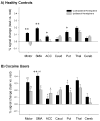Loss of laterality in chronic cocaine users: an fMRI investigation of sensorimotor control
- PMID: 19959345
- PMCID: PMC2794910
- DOI: 10.1016/j.pscychresns.2009.07.009
Loss of laterality in chronic cocaine users: an fMRI investigation of sensorimotor control
Abstract
Movement disturbances are often overlooked consequences of chronic cocaine abuse. The purpose of this study was to systematically investigate sensorimotor performance in chronic cocaine users and characterize changes in brain activity among movement-related regions of interest (ROIs) in these users. Functional magnetic resonance imaging data were collected from 14 chronic cocaine users and 15 age- and gender-matched controls. All participants performed a sequential finger-tapping task with their dominant, right hand interleaved with blocks of rest. For each participant, percent signal change from rest was calculated for seven movement-related ROIs in both the left and right hemisphere. Cocaine users had significantly longer reaction times and higher error rates than controls. Whereas the controls used a left-sided network of motor-related brain areas to perform the task, cocaine users activated a less lateralized pattern of brain activity. Users had significantly more activity in the ipsilateral (right) motor and premotor cortical areas, anterior cingulate cortex and the putamen than controls. These data demonstrate that, in addition to the cognitive and affective consequences of chronic cocaine abuse, there are also pronounced alterations in sensorimotor control in these individuals, which are associated with functional alterations throughout movement-related neural networks.
Conflict of interest statement
The authors have no conflicts of interest to declare.
Figures





Similar articles
-
The effect of task difficulty on motor performance and frontal-striatal connectivity in cocaine users.Drug Alcohol Depend. 2017 Apr 1;173:178-184. doi: 10.1016/j.drugalcdep.2016.12.008. Epub 2017 Jan 21. Drug Alcohol Depend. 2017. PMID: 28260681 Free PMC article.
-
Loss of functional specificity in the dorsal striatum of chronic cocaine users.Drug Alcohol Depend. 2009 Jun 1;102(1-3):88-94. doi: 10.1016/j.drugalcdep.2009.01.005. Epub 2009 Mar 4. Drug Alcohol Depend. 2009. PMID: 19264428 Free PMC article.
-
A functional MRI study of motor dysfunction in Friedreich's ataxia.Brain Res. 2012 Aug 30;1471:138-54. doi: 10.1016/j.brainres.2012.06.035. Epub 2012 Jul 3. Brain Res. 2012. PMID: 22771856
-
Can left-handedness be switched? Insights from an early switch of handwriting.J Neurosci. 2007 Jul 18;27(29):7847-53. doi: 10.1523/JNEUROSCI.1299-07.2007. J Neurosci. 2007. PMID: 17634378 Free PMC article.
-
Error processing in current and former cocaine users.Brain Imaging Behav. 2014 Mar;8(1):87-96. doi: 10.1007/s11682-013-9247-y. Brain Imaging Behav. 2014. PMID: 23949893 Free PMC article.
Cited by
-
A comprehensive study of sensorimotor cortex excitability in chronic cocaine users: Integrating TMS and functional MRI data.Drug Alcohol Depend. 2015 Dec 1;157:28-35. doi: 10.1016/j.drugalcdep.2015.07.1196. Epub 2015 Sep 26. Drug Alcohol Depend. 2015. PMID: 26541870 Free PMC article.
-
Preliminary evidence of motor impairment among polysubstance 3,4-methylenedioxymethamphetamine users with intact neuropsychological functioning.J Int Neuropsychol Soc. 2010 Nov;16(6):1047-55. doi: 10.1017/S1355617710000846. Epub 2010 Aug 25. J Int Neuropsychol Soc. 2010. PMID: 20735886 Free PMC article.
-
Error processing and gender-shared and -specific neural predictors of relapse in cocaine dependence.Brain. 2013 Apr;136(Pt 4):1231-44. doi: 10.1093/brain/awt040. Epub 2013 Mar 12. Brain. 2013. PMID: 23485852 Free PMC article.
-
The association between frontal-striatal connectivity and sensorimotor control in cocaine users.Drug Alcohol Depend. 2011 Jun 1;115(3):240-3. doi: 10.1016/j.drugalcdep.2010.11.008. Epub 2010 Dec 28. Drug Alcohol Depend. 2011. PMID: 21193273 Free PMC article.
-
The Effects of Digital Addiction on Brain Function and Structure of Children and Adolescents: A Scoping Review.Healthcare (Basel). 2023 Dec 20;12(1):15. doi: 10.3390/healthcare12010015. Healthcare (Basel). 2023. PMID: 38200921 Free PMC article.
References
-
- Ashburner J, Friston KJ. Unified segmentation. Neuroimage. 2005;26:839–851. - PubMed
-
- Babiloni C, Carducci F, Del Gratta C, Demartin M, Romani GL, Babiloni F, Rossini PM. Hemispherical asymmetry in human SMA during voluntary simple unilateral movements. An fMRI study. Cortex. 2003;39:293–305. - PubMed
-
- Bauer LO. Resting hand tremor in abstinent cocaine-dependent, alcohol-dependent, and polydrug-dependent patients. Alcohol Clin Exp Res. 1996;20:1196–1201. - PubMed
-
- Boecker H, Kleinschmidt A, Requardt M, Hanicke W, Merboldt KD, Frahm J. Functional cooperativity of human cortical motor areas during self-paced simple finger movements. A high-resolution MRI study. Brain. 1994;117 (Pt 6):1231–1239. - PubMed
Publication types
MeSH terms
Substances
Grants and funding
LinkOut - more resources
Full Text Sources
Medical

